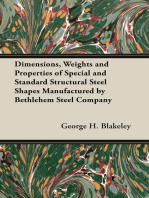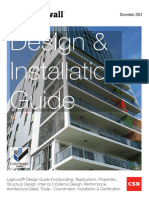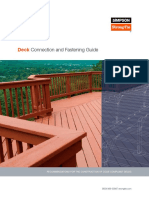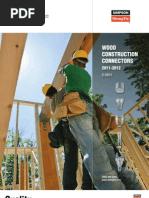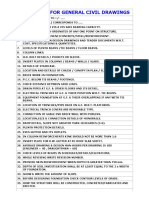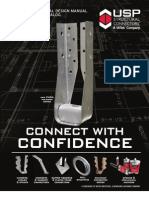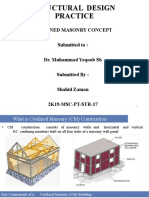C HW09
C HW09
Uploaded by
hayeska3527Copyright:
Available Formats
C HW09
C HW09
Uploaded by
hayeska3527Original Title
Copyright
Available Formats
Share this document
Did you find this document useful?
Is this content inappropriate?
Copyright:
Available Formats
C HW09
C HW09
Uploaded by
hayeska3527Copyright:
Available Formats
The expiration date of this document has been extended until 12/31/11.
HIGH WINDRESISTANT CONSTRUCTION
C-HW09
(800) 999-5099 www.strongtie.com
STRENGTH
Steel Strong-Wall shearwall shake table test Simpson Strong-Tie Tye Gilb test facility Stockton, CA
Presenting our Lateral Systems
Little did we know
when we introduced our rst holdown in 1966 that our product innovations would lead us to solutions that can help hold together ve-story buildings during an earthquake or allow builders to install larger window and door openings in homes. Our offering of lateral-force resisting systems, including Wood and Steel Strong-Wall shearwalls, Anchor Tiedown Systems and new Strong Frame moment frames, gives designers and engineers added design exibility in wood-frame construction and the condence that almost anything is possible.
At Simpson Strong-Tie, we believe that strength really does come in numbers. By offering the largest selection of lab and eld-tested lateral-force resisting systems along with dedicated engineers and eld support reps to back them up, you can count on the strength of our products and our people to perform. Whether youre designing or building a single-family home, a six-story mixed-used building or a retail store, we know we have a solution to t your project and meet the most stringent code requirements. And were not done yet. The research, testing and
structural system technology thats to come has us just as excited as we st were when we developed that rst eloped holdown. With each new product and h design innovation, were working with the industry to increase the structural ease safety of homes and buildings around d the country. And in light of all the n hurricanes and earthquakes weve thquakes experienced during the last 40 years, thats a pretty good feeling. d
visit: To learn more, visit: www.strongtie.com/lateralsystems www.strongtie.com m/lateralsystems
Steel Strong-Wall shearwalls
Strong Frame moment frames
Anchor Tiedown Systems wn
High Wind-Resistant Construction
WIND EFFECTS
Wind forces are generated from natural events like thunderstorms, hurricanes and tornadoes. These winds create forces that attack the integrity of a structure in multiple ways: vertically, resulting in uplift forces, and horizontally, resulting in overturning, sliding and racking forces. Without proper design and construction, these forces can produce structural damage and even destruction. Modern design and construction practices, such as structural connectors used in a continuous load path transfer system, can effectively resist these forces by reinforcing the structure from the roof to the foundation.
CS
H10A
When wind ows over the roof of the structure, creating a strong lifting force on the roof which can cause it to break away.
TSP
SPH4
When wind blows against the side of the structure exerting a lateral force that causes it to lean over (rack) to one side.
Strong-Wall Shearwall
Steel Strong-Wall Shearwall
Strong Frame Ordinary Moment Frame
C-HW09 2009 SIMPSON STRONG-TIE COMPANY INC.
Titen HD Anchor MASA
When wind blows against the side of the structure exerting a lateral force, causing it to slide off of its foundation.
HDU
HTT22
When the structure is anchored in place to limit racking or sliding, the lateral force of the wind causes the structure to rotate or overturn.
4
High Wind-Resistant Construction
TABLE OF CONTENTS
Wind Effects ................................................................................... 4 General Information ....................................................................... 8 Corrosion Information ................................................................. 8-9 Coatings Available ........................................................................... 9 Fasteners ................................................................................... 10-11 Truss/Rafter to Wood Double Top Plates ..................................... 12 Girder/Truss to Wall Framing ......................................................... 13 I-Joists to Wall Framing ............................................................... 14 I-Joists to Masonry/Concrete ..................................................... 14 Embedded Truss/Rafter to Masonry/Concrete ........................... 15 Post Installed Truss/Rafter to Masonry/Concrete ...................... 16 Girder/Truss to Masonry/Concrete ............................................. 17 Truss/Rafter Hip to Wall ............................................................... 18 Truss/Rafter Hip to End Wall ......................................................... 18 Truss/Rafter to Single Top Plate .................................................... 19 Hollow Column Uplift .................................................................... 19 Truss/Rafter to Stud ..................................................................... 20 Top Plates to Stud ........................................................................ 20 Stud to Band Joist ........................................................................ 21 Stud to Stud ................................................................................. 21 Floor to Masonry/Concrete ........................................................... 22 Stud to Sill Plate ........................................................................... 23 Sill Plate to Foundation ................................................................ 23 Header to Wall Framing ................................................................ 24 Alternative Wind Uplift Restraint System ................................... 25 Stemwall/Crawlspace ................................................................... 26 Pile/Girder to Wall ....................................................................... 27 Post/Column to Beam ................................................................... 28 Corner Post/Column to Beam ...................................................... 29 Post/Column to Foundation ......................................................... 30 Roof Boundary Connection .......................................................... 31 Lateral Load ................................................................................. 31 Holdowns ...................................................................................... 32 Steel Strong-Wall Shearwall ..................................................... 33 Wood Strong-Wall Shearwall .................................................... 34 Gable End to Wall Framing .......................................................... 35 Valley Truss to Roof Framing ....................................................... 36 Drag Strut Connection ................................................................. 36 Hanger Uplift Considerations ....................................................... 37 Load Path Installation Considerations .................................. 38-39
THE SIMPSON STRONG-TIE QUALITY POLICY
We help people build safer structures economically. We do this by designing, engineering and manufacturing No Equal structural connectors and other related products that meet or exceed our customers needs and expectations. Everyone is responsible for product quality and is committed to ensuring the effectiveness of the Quality Management System.
GETTING FAST TECHNICAL SUPPORT
When you call for engineering technical support, we can help you quickly if you have the following information at hand. This will help us to serve you promptly and efficiently. Which Simpson Strong-Tie catalog are you using? (See the front cover for the catalog number) Which Simpson Strong-Tie product are you using? What is your load requirement? What is the carried members width and height? What is the supporting members width and height? What is the carried and supporting members material and application?
C-HW09 2009 SIMPSON STRONG-TIE COMPANY INC.
Tom Fitzmyers
Chief Executive Officer
Terry Kingsfather
President
Call 800-999-5099 | www.strongtie.com
HOW TO USE THIS CATALOG
NEW PRODUCTS
New products are shown with the symbol. There are also many new sizes within existing model series.
EXTRA CORROSION PROTECTION
This icon identifies products that are available with additional corrosion protection (ZMAX, Hot-Dip Galvanized, stainless steel or the SDS double-barrier coating). Other products may also be available with additional protection, contact Simpson Strong-Tie for options. The end of the product name will indicate what type of extra corrosion protection is provided (Z = ZMAX, HDG = Hot-Dip Galvanized or SS = stainless steel). See page 8-9 for information on corrosion, and visit our website www.strongtie.com/info for more technical information on this topic. December 31, 2011
This catalog reects changes in the allowable loads and congurations of some Simpson Strong-Tie Company Inc. products. This catalog is effective until December 31, 2010, and supersedes all information in earlier publications, including catalogs, brochures, iers, technical bulletins, etc. Use this edition as a current reference. Information on allowable loads and congurations is updated periodically. After December 31, 2010, contact Simpson Strong-Tie Company Inc. for the most current product information. Allowable loads in this catalog are for the described specic applications of properly-installed products. Product modications, improper loading, installation procedures, or deviations from recommended applications will affect connector allowable load-carrying capacities.
You might also like
- Column SizeDocument9 pagesColumn SizeV.m. Rajan71% (7)
- Fisher & Ludlow Catalogue PDFDocument48 pagesFisher & Ludlow Catalogue PDFalinawaz9185% (13)
- A Comprehensive Guide to Composites: Processes & Procedures from the ProfessionalsFrom EverandA Comprehensive Guide to Composites: Processes & Procedures from the ProfessionalsRating: 5 out of 5 stars5/5 (2)
- Fundamentals of Building Construction: Materials and MethodsFrom EverandFundamentals of Building Construction: Materials and MethodsRating: 4 out of 5 stars4/5 (3)
- SIMPSON - Strong-Wall Shearwalls Prescriptive Design GuideDocument84 pagesSIMPSON - Strong-Wall Shearwalls Prescriptive Design Guidekiss_5985678650% (2)
- HumeSlab Tech ManualDocument60 pagesHumeSlab Tech ManualKc TanNo ratings yet
- Reinforced Concrete Grade Beams, Piles & Caissons: A Practical Guide for Hillside ConstructionFrom EverandReinforced Concrete Grade Beams, Piles & Caissons: A Practical Guide for Hillside ConstructionNo ratings yet
- Reinforced Concrete Buildings: Behavior and DesignFrom EverandReinforced Concrete Buildings: Behavior and DesignRating: 5 out of 5 stars5/5 (1)
- Dimensions, Weights and Properties of Special and Standard Structural Steel Shapes Manufactured by Bethlehem Steel CompanyFrom EverandDimensions, Weights and Properties of Special and Standard Structural Steel Shapes Manufactured by Bethlehem Steel CompanyNo ratings yet
- 153: Ty Ambrose Farm, Building Recording, APAC LTDDocument85 pages153: Ty Ambrose Farm, Building Recording, APAC LTDAPAC LtdNo ratings yet
- C-HW09 Simpson CatalogDocument44 pagesC-HW09 Simpson CatalogLee WinklerNo ratings yet
- Simson Strong Wall Design ManualDocument84 pagesSimson Strong Wall Design ManualVishal Ghule100% (1)
- Steel Roof Truss TutorialDocument6 pagesSteel Roof Truss Tutorialsundar_s_2k100% (1)
- Simpson Strong Tie Catalog 09Document196 pagesSimpson Strong Tie Catalog 09Jeff Strickland100% (1)
- Simpson C-CLT-AUNZ22Document20 pagesSimpson C-CLT-AUNZ22sahil kapadiaNo ratings yet
- Simpson Strong Frame Ordinary Moment FrameC-SF10Document68 pagesSimpson Strong Frame Ordinary Moment FrameC-SF10Debo SodipoNo ratings yet
- Span CastDocument20 pagesSpan CastAddrien DanielNo ratings yet
- SFP Catalog 3 Fabric Exp JointsDocument32 pagesSFP Catalog 3 Fabric Exp JointsJosé MoránNo ratings yet
- Anchored Sheet-Pile WallsDocument68 pagesAnchored Sheet-Pile WallsJose MartinezNo ratings yet
- Deck Building GuidelineDocument20 pagesDeck Building GuidelineAnonymous JWjRYSy100% (1)
- LokSeam Manual - 2019Document84 pagesLokSeam Manual - 2019albertmunoz998No ratings yet
- Walraven USA Product Catalog 2020 2021Document75 pagesWalraven USA Product Catalog 2020 2021zaxaxazNo ratings yet
- Ewpaa Structural Plywood Wall BracingDocument34 pagesEwpaa Structural Plywood Wall BracingmlamourNo ratings yet
- Shoring FrameFast Shoring System Application GuideDocument23 pagesShoring FrameFast Shoring System Application GuideJairo GüetoNo ratings yet
- Cold Formed Steel Framing System CatalogDocument32 pagesCold Formed Steel Framing System CatalogMujjo SahbNo ratings yet
- Advanced Construction TechnologyDocument41 pagesAdvanced Construction TechnologyBCAS HND QS Assignment100% (1)
- AFS Logicwall® Design Installation GuideDocument278 pagesAFS Logicwall® Design Installation GuidedeanNo ratings yet
- UltraDek ManualDocument89 pagesUltraDek Manualbsh117No ratings yet
- Connection and Fastening Guide: Recommendations For The Construction of Code-Compliant DecksDocument40 pagesConnection and Fastening Guide: Recommendations For The Construction of Code-Compliant DecksbassigwNo ratings yet
- Estrutura de Madeira ConexõesDocument40 pagesEstrutura de Madeira ConexõesSérgio MoreiraNo ratings yet
- Simpson Strong-Tie - Wood Construction Connectors - 2011Document216 pagesSimpson Strong-Tie - Wood Construction Connectors - 2011arquitrol100% (1)
- Testing Procedures For High Output Fluid Viscous Dampers Used in Structures To Dissipate Seismic EnergyDocument11 pagesTesting Procedures For High Output Fluid Viscous Dampers Used in Structures To Dissipate Seismic EnergyJoaquínValenzuelaBarbosaNo ratings yet
- Mammut 350: Technical Instruction ManualDocument70 pagesMammut 350: Technical Instruction ManualNazmulNo ratings yet
- Structural DampersDocument78 pagesStructural DampersJithin PayyanurNo ratings yet
- Building Deck Framing Connection GuideDocument28 pagesBuilding Deck Framing Connection GuideMelendres Benito100% (2)
- C & Zed Purlins Design Manual and Catalogue BC783d01Document31 pagesC & Zed Purlins Design Manual and Catalogue BC783d01GnabBangNo ratings yet
- C 2011Document243 pagesC 2011xicmenNo ratings yet
- Structural Engineering OverviewDocument40 pagesStructural Engineering OverviewPatrick Kelly FontanillaNo ratings yet
- Architectural Connections GuideDocument70 pagesArchitectural Connections GuideTSGSSNo ratings yet
- Architectural Connections GuideDocument70 pagesArchitectural Connections GuideTon LeeNo ratings yet
- Building in High Wind and Seismic Zones (APA)Document8 pagesBuilding in High Wind and Seismic Zones (APA)IonFlorentaNo ratings yet
- Lateral Stability of Building Structures (Rev. Ed.), Wolfgang SchuellerDocument148 pagesLateral Stability of Building Structures (Rev. Ed.), Wolfgang Schuellerwolfschueller90% (10)
- Fireboard Systeme Fib01 de 0118 0 Eng ScreenDocument98 pagesFireboard Systeme Fib01 de 0118 0 Eng ScreenCojan CarinaNo ratings yet
- Simpson Strong-Tie Strongwall Catalog C-L-SW14Document116 pagesSimpson Strong-Tie Strongwall Catalog C-L-SW14Debo SodipoNo ratings yet
- Residential Asphalt Roofing Manual Design and Application Methods 2014 EditionFrom EverandResidential Asphalt Roofing Manual Design and Application Methods 2014 EditionNo ratings yet
- Log Cabins and Outbuildings: A Guide to Building Homes, Barns, Greenhouses, and MoreFrom EverandLog Cabins and Outbuildings: A Guide to Building Homes, Barns, Greenhouses, and MoreRating: 5 out of 5 stars5/5 (1)
- Time-dependent Behaviour and Design of Composite Steel-concrete StructuresFrom EverandTime-dependent Behaviour and Design of Composite Steel-concrete StructuresNo ratings yet
- Essential Rammed Earth Construction: The Complete Step-by-Step GuideFrom EverandEssential Rammed Earth Construction: The Complete Step-by-Step GuideNo ratings yet
- Warehouse & Working Facilities Complex at Sreepur, Gazipur, Bangladesh. 11-07-17 22 LB PER SFT PDFDocument7 pagesWarehouse & Working Facilities Complex at Sreepur, Gazipur, Bangladesh. 11-07-17 22 LB PER SFT PDFAbdullah Omar NasseefNo ratings yet
- Code-Compliant Guardrail Post Connections: Technical BulletinDocument4 pagesCode-Compliant Guardrail Post Connections: Technical BulletinbassigwNo ratings yet
- Building Construction Theory 2 NotesDocument45 pagesBuilding Construction Theory 2 Notesbaluku samuelNo ratings yet
- JDE-PT-MST-0009 - 0 Steel Structure Erection and Slab Opening Reinforcement WorksDocument45 pagesJDE-PT-MST-0009 - 0 Steel Structure Erection and Slab Opening Reinforcement WorksTashaNo ratings yet
- N3 Building Drawing April 2018Document7 pagesN3 Building Drawing April 2018Brandon Van niekerkNo ratings yet
- Adhesives in Building ConstructionDocument165 pagesAdhesives in Building ConstructionErAC100% (1)
- Check List For Civil DrawingsDocument2 pagesCheck List For Civil Drawingsnirmal sutharNo ratings yet
- Trusses IV Composite and Raised Bottom Chord TrussesDocument18 pagesTrusses IV Composite and Raised Bottom Chord TrussesCristian Morar-BolbaNo ratings yet
- Jan Wium - ReinforcementDocument26 pagesJan Wium - ReinforcementnasyahrahNo ratings yet
- Seismic Retrofit GuideDocument20 pagesSeismic Retrofit Guide오상진No ratings yet
- Base Isolation HISTORYDocument8 pagesBase Isolation HISTORYIrfan MughalNo ratings yet
- 56th USP Structural ConnectorsDocument204 pages56th USP Structural ConnectorsarquitrolNo ratings yet
- Tied Foundations-Portal FrameDocument3 pagesTied Foundations-Portal FrameJaime Manalili LandinginNo ratings yet
- HOA Quiz 2Document67 pagesHOA Quiz 2Yen DaNo ratings yet
- Fencing Oman With Block Footing - 03072013Document20 pagesFencing Oman With Block Footing - 03072013RAJENDRA PRASADNo ratings yet
- Swedbank Arena Roof ConstructionDocument4 pagesSwedbank Arena Roof ConstructionKarla AmarNo ratings yet
- HUGHES - Cator and Cribbage Construction of Northern PakistanDocument12 pagesHUGHES - Cator and Cribbage Construction of Northern PakistanFayaz JerovNo ratings yet
- Conexiones Framecad-SimpsomDocument20 pagesConexiones Framecad-Simpsomfabian andres martinez ayalaNo ratings yet
- Strongwall Shearwalls CatalogDocument116 pagesStrongwall Shearwalls CataloggullipalliNo ratings yet
- Confined Masonry (2019-MSC-STR-PT-17)Document74 pagesConfined Masonry (2019-MSC-STR-PT-17)Irfan MunirNo ratings yet
- Conventional Wood Frame ConstructionDocument55 pagesConventional Wood Frame Constructioncrysty9986% (7)
- Loft ConversionDocument44 pagesLoft Conversionn67250100% (1)
- Roofing ManualDocument238 pagesRoofing ManualMario M. Navallasca100% (2)
- CE2352 DSS 2 Marks With AnswerDocument33 pagesCE2352 DSS 2 Marks With Answerkavithamartin28No ratings yet
- Drawing 1.Document1 pageDrawing 1.tiyaniNo ratings yet
- 30 Different Types of Roof Trusses, Parts of Roof Trusses and GutterDocument50 pages30 Different Types of Roof Trusses, Parts of Roof Trusses and GutterCaryl Louise ObcianaNo ratings yet
- Historical Earthquake Resistant Timber FDocument175 pagesHistorical Earthquake Resistant Timber Fafzal.psd22012100% (1)








